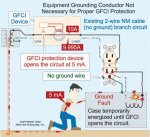Understood and it also has (E), but the point is that none of these paragraphs describe a recreational vehicle site or stand. An RV site is not a dwelling unit (A), not an "other than dwelling unit" (B) (which still must be a building), not a boat hoist (C), not a kitchen dishwasher branch circuit (D), and not a crawl space lighting outlet (E).
And if 210.8 encompassed all aspects of RV sites, there would be no need for a redundant requirement in 551.71(F). As (F) has language change updates for 2017, it's unlikely it was simply overlooked when 210.8 was updated.
There are also requirements for mobile home and park model homes that have 40, 50 and 60 amp services...there's no way the Code now requires those homes supplied via a cord and plug to have GFCI protection.
I don't agree with the interpretation that "other than dwelling unit" applies to anything other than installations in or on or supplied from buildings.
Yet another disturbance in The Force caused by vague or non-existent definitions.


